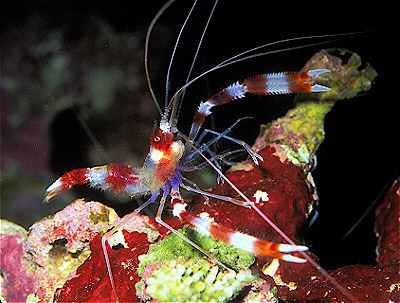Commensalism: Difference between revisions
| Line 1: | Line 1: | ||
= Commensalism = | = Commensalism = | ||
== What is it?== | == What is it?== | ||
A form of [[symbiosis]] "in which the symbiont benefits but there is an insignificant, or at least poorly known, effect on its host." <ref name="sumich">Sumich, James L. An Introduction to the Biology of Marine Life, Seventh Edition. WCB/McGraw Hill. 1999.</ref> | [[File:c-BandCoral.jpg]] A form of [[symbiosis]] "in which the symbiont benefits but there is an insignificant, or at least poorly known, effect on its host." <ref name="sumich">Sumich, James L. An Introduction to the Biology of Marine Life, Seventh Edition. WCB/McGraw Hill. 1999.</ref> | ||
===Coral Reef Commensalism=== | ===Coral Reef Commensalism=== | ||
Revision as of 15:17, 25 February 2015
Commensalism
What is it?
 A form of symbiosis "in which the symbiont benefits but there is an insignificant, or at least poorly known, effect on its host." [1]
A form of symbiosis "in which the symbiont benefits but there is an insignificant, or at least poorly known, effect on its host." [1]
Coral Reef Commensalism
While most example of commensalism in reef habitats occur between other species like fish and sea cucumbers and anemones, there are several instances of commensal relations between coral and shrimps and crabs that important to ecosystem function.
1. Pocilloporid and coral gall crabs
From Aspects of the groth and reproduction of the coral gall crab Hapalocarcinus marsupialis, conducted by Marine Science Department at Suez Canal University:
o family pocilloporidae, genera pocillopora, stylophora, seriatopora
2. Petroglyph shrimp and Porites lobata
From A review of information upon the coral hosts of commensal shrimps of the sub-family Pontoninae original research by Kingsley 1878, review by A.J. Bruce at the Fisheries Research Station of Hong Kong
3. Acropora nasuta and reef fish
From Corals chemically cue mutualistic fishes to remove competing seaweeds, conducted by Danielle Dixon and Mark Hay for the National Insitute for Health
- coral goby cleans seaweed off corals, preventing the seaweed from taking up the coral’s source of sunlight - the toothy or common ghost goby seeks protection amongst soft corals in the Indo-Pacific ocean
References
Resources consulted:
http://ocean.si.edu/ocean-photos/coral-goby-cleans-coral
http://krupp.wcc.hawaii.edu/BIOL200/powerpnt/pdffiles/symbiosis.pdf
Aspects of the Growth and Reproduction of the Coral Gall Crab Hapalocarcinus marsupialis Author(s): Mohammed M. A. Kotb and Richard G. Hartnoll Source: Journal of Crustacean Biology, Vol. 22, No. 3 (Aug., 2002), pp. 558-566 Published by: {brill} on behalf of The Crustacean Society Stable URL: http://www.jstor.org/stable/1549739 Accessed: 25-02-2015
- ↑ Sumich, James L. An Introduction to the Biology of Marine Life, Seventh Edition. WCB/McGraw Hill. 1999.